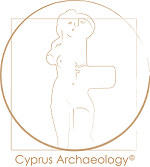Love as seen through art in ancient Cyprus: a terracotta complex of love and passion. The myth of the two lovers dates back to the Hellenistic times, in Greek art as early as the 4th century BC. The written story comes from the Metamorphoses written in the 2nd century AD by Lucius Apuleius Madaurensis. ItContinue reading “Eros & Physche”
Category Archives: #art
The seated kourotrophoi
A Kourotrophos figure represents a woman holding a child in her arms or on her knees. This theme is well attested in the context of the Mediterranean civilizations, particularly in Cyprus, from the Early Bronze Age to the Hellenistic period. The term kourotrophos is the most frequently used term to designate this particular kind ofContinue reading “The seated kourotrophoi”
Ayios Mamas: a medieval chapel in Sotira, Ammochostos
A small medieval chapel, dedicated to Ayios Mamas, is situated in Sotira, Ammochostos District, a fine example of the single, octagonal domed Frankish-Byzantine chapels in Cyprus. Ayios Mamas is situated in close distance to the Church of Metamorphosis, another Byzantine monument in Sotira, and approx. 10km to the south of Ammochostos city. The chapel wasContinue reading “Ayios Mamas: a medieval chapel in Sotira, Ammochostos”
The Church of Panagia Katholiki
Dating back to medieval times, Panagia Katholiki was the main church of the people of Kouklia (Palaepaphos) at that time. The Church and the Lusignian Manor House are the oldest medieval structures of the ancient city. The Church of Panagia Katholiki is situated just next to the famous Sanctuary of Aphrodite in Palaepaphos. It wasContinue reading “The Church of Panagia Katholiki”
A unique White Painted V oval amphora from ancient Idalion
This unique piece of Archaic pottery was discovered in 1928, during the Swedish Cyprus Expedition at the ancient Kingdom of Idalion. This White Painted V oval amphora with base-ring, was discovered at the Western Acropolis of Idalion by the Swedish Cyprus Expedition around 1928. The item was found in pieces and it was fully restored.Continue reading “A unique White Painted V oval amphora from ancient Idalion”
Ancient Cyprus: through the eyes of cartographers
Cartography is defined as the art of map-making and map-designing that ”integrates science, technology and visual aesthetics for the purposes of rendering the domain of interest, navigable” (Thomas & Zaytseva, 2016). The study of cartography, through history, provides valuable information about the development, the makers, the sources, ideas, theories as well as the technology implementedContinue reading “Ancient Cyprus: through the eyes of cartographers”
A unique silver-gilt bowl: An amalgam of civilizations
Cyprus, since antiquity, is a crossroad of civilizations. The geographical position of the island, situated in the most eastern part of the Mediterranean, renders it a crossroad, a candle of civilizations. This is evident through the examination of the material culture excavated in the island. Foreign influences can be seen not only in the importedContinue reading “A unique silver-gilt bowl: An amalgam of civilizations”
The necropolis of Alaas, Carpasia
Alaas necropolis is situated in the Carpass peninsula, about 3km south-east of the village of Gastria. The area consists of low rolling hills of chavara rock covered by sparse forest and interspersed by cultivated fields. The site is located in the forest of Valia. Rescue excavations and a surface survey took place between 1973-1974. TheContinue reading “The necropolis of Alaas, Carpasia”








